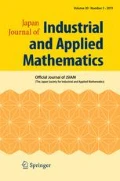Abstract
Gradient systems on manifolds of various probability distributions are presented. It is shown that the gradient systems can be linearized by the Legendre transformation. It follows that the corresponding flows on the manifolds converge to equilibrium points of potential functions exponentially. It is proved that gradient systems on manifolds of even dimensions are completely integrable Hamiltonian systems. Especially, the gradient system for the Gaussian distribution admits a Lax pair representation.
Similar content being viewed by others
References
S. Amari, Differential-Geometrical Methods in Statistics. Lecture Notes in Statist. Vol. 28, Springer-Verlag, Berlin, 1985.
D.A. Bayer and J.C. Lagarias, The nonlinear geometry of linear programming. II. Legendre transform coordinates and central trajectories. Trans. Amer. Math. Soc.,314 (1989), 527–581.
R.W. Brockett, Dynamical systems that sort lists, diagonalize matrices and solve linear programming problem. Linear Algebra Appl.,146 (1991), 79–91.
I.I. Dikin, Iterative solution of problems of linear and quadratic programming. Soviet Math. Dokl.,8 (1967), 674–675.
A. Fujiwara, Dynamical systems on statistical models. Recent Developments and Perspectives in Nonlinear Dynamical Systems (eds. Y. Nakamura, K. Takasaki and K. Nagatomo), RIMS Kokyuroku No. 822, Kyoto Univ., Kyoto 1993, 32–42.
M.W. Hirsch, and S. Smale, Differential Equations, Dynamical Systems, and Linear Algebra. Pure Appl. Math., Vol. 5, Academic Press, New York, 1974.
N. Karmarkar, A new polynomial time algorithm for linear programming. Combinatorica,4 (1984), 373–395.
N. Karmarkar, Riemannian geometry underlying interior-point methods for linear programming. Mathematical Developments Arising from Linear Programming (eds. J.C. Lagarias and M.J. Todd), Contemp. Math., Vol. 114, Amer. Math. Soc., Providence, 1990, 51–75.
J.C. Lagarias, The nonlinear geometry of linear programming. III. Projective Legendre transform coordinates and Hilbert geometry. Trans. Amer. Math. Soc.,320 (1990), 193–225.
J. Moser, Finitely many points on the line under the influence of an exponential potential — An integrable system. Dynamical Systems, Theory and Applications (ed. J. Moser), Lecture Notes in Phys., Vol. 38, Springer-Verlag, Berlin, 1975, 467–497.
Y. Nakamura, Lax equations associated with a least squares problem and compact Lie algebras. Recent Developments in Differential Geometry (ed. K. Shiohama), Adv. Stud. Pure Math., Vol. 22, Math. Soc. Japan, 1993, 213–229.
Y. Nakamura, Completely integrable gradient systems on the manifolds of Gaussian and multinomial distributions. Japan J. Indust. Appl. Math.,10 (1993), 179–189.
K. Tanabe, A geometric method in nonlinear programming. J. Optim. Theory Appl.,30 (1980), 181–210.
K. Tanabe and T. Tsuchiya, New geometry in linear programming (in Japanese). Math. Sci., No. 303, 1988, 32–37.
Author information
Authors and Affiliations
About this article
Cite this article
Nakamura, Y. Gradient systems associated with probability distributions. Japan J. Indust. Appl. Math. 11, 21–30 (1994). https://doi.org/10.1007/BF03167211
Received:
Issue Date:
DOI: https://doi.org/10.1007/BF03167211



